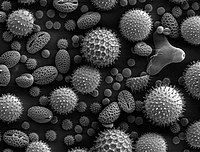
Role of respiratory terminal oxidases in the extracellular electron transfer ability of cyanobacteria.
Sign Up to like & getrecommendations! Published in 2018 at "Biotechnology and bioengineering"
DOI: 10.1002/bit.26542
Abstract: Cyanobacteria are used as anode catalysts in photo-bioelectrochemical cells to generate electricity in a sustainable, economic, and environmental friendly manner using only water and sunlight. Though cyanobacteria (CB) possess unique advantage for solar energy conversion… read more here.
Keywords: extracellular electron; oxidase; electron transfer; type ... See more keywords

Molecular underpinnings for microbial extracellular electron transfer during biogeochemical cycling of earth elements
Sign Up to like & getrecommendations! Published in 2019 at "Science China Life Sciences"
DOI: 10.1007/s11427-018-9464-3
Abstract: Microbial extracellular electron transfer (EET) is electron exchanges between the quinol/quinone pools in microbial cytoplasmic membrane and extracellular substrates. Microorganisms with EET capabilities are widespread in Earth hydrosphere, such as sediments of rivers, lakes and… read more here.
Keywords: extracellular electron; microbial extracellular; electron transfer; biogeochemical cycling ... See more keywords

Mathematical modelling of microbial corrosion in carbon steel due to early-biofilm formation of sulfate-reducing bacteria via extracellular electron transfer.
Sign Up to like & getrecommendations! Published in 2022 at "Bioelectrochemistry"
DOI: 10.1016/j.bioelechem.2022.108058
Abstract: Sulfate-reducing bacteria (SRB) are the most studied microorganisms related to severe episodes of microbially influenced corrosion (MIC). A mechanism used by SRB to corrode steel alloys is the extracellular electron transfer (EET), which was described… read more here.
Keywords: extracellular electron; corrosion; electron transfer; reducing bacteria ... See more keywords

GSU1771 regulates extracellular electron transfer and electroactive biofilm formation in Geobacter sulfurreducens: Genetic and electrochemical characterization.
Sign Up to like & getrecommendations! Published in 2022 at "Bioelectrochemistry"
DOI: 10.1016/j.bioelechem.2022.108101
Abstract: Type IV pili and the >100c-type cytochromes in Geobacter sulfurreducens are essential for extracellular electron transfer (EET) towards metal oxides and electrodes. A previous report about a mutation in the gsu1771 gene indicated an enhanced… read more here.
Keywords: extracellular electron; geobacter sulfurreducens; gsu1771 regulates; electron transfer ... See more keywords

Enhanced Bioreduction of Radionuclides by Driving Microbial Extracellular Electron Pumping with an Engineered CRISPR Platform.
Sign Up to like & getrecommendations! Published in 2021 at "Environmental science & technology"
DOI: 10.1021/acs.est.1c03713
Abstract: Dissimilatory metal-reducing bacteria (DMRB) with extracellular electron transfer (EET) capability show great potential in bioremediating the subsurface environments contaminated by uranium through bioreduction and precipitation of hexavalent uranium [U(VI)]. However, the low EET efficiency of… read more here.
Keywords: extracellular electron; crispr platform; engineered crispr; platform ... See more keywords

Extracellular Electron Transfer Enables Cellular Control of Cu(I)-Catalyzed Alkyne–Azide Cycloaddition
Sign Up to like & getrecommendations! Published in 2022 at "ACS Central Science"
DOI: 10.1021/acscentsci.1c01208
Abstract: Extracellular electron transfer (EET) is an anaerobic respiration process that couples carbon oxidation to the reduction of metal species. In the presence of a suitable metal catalyst, EET allows for cellular metabolism to control a… read more here.
Keywords: control; electron transfer; eet; extracellular electron ... See more keywords

Disparity of Cytochrome Utilization in Anodic and Cathodic Extracellular Electron Transfer Pathways of Geobacter sulfurreducens Biofilms
Sign Up to like & getrecommendations! Published in 2020 at "Journal of the American Chemical Society"
DOI: 10.1021/jacs.9b13077
Abstract: Extracellular electron transfer (EET) in microorganisms is prevalent in nature and has been utilized in functional bioelectrochemical systems. EET of Geobacter sulfurreducens has been extensively studied and has been revealed to be facilitated through c-type… read more here.
Keywords: extracellular electron; geobacter sulfurreducens; electron transfer; anodic cathodic ... See more keywords

Identification of a pathway for electron uptake in Shewanella oneidensis
Sign Up to like & getrecommendations! Published in 2021 at "Communications Biology"
DOI: 10.1038/s42003-021-02454-x
Abstract: Extracellular electron transfer (EET) could enable electron uptake into microbial metabolism for the synthesis of complex, energy dense organic molecules from CO 2 and renewable electricity 1 – 6 . Theoretically EET could do this… read more here.
Keywords: extracellular electron; electron uptake; shewanella oneidensis; electron ... See more keywords

Flavin-mediated extracellular electron transfer in Gram-positive bacteria Bacillus cereus DIF1 and Rhodococcus ruber DIF2
Sign Up to like & getrecommendations! Published in 2019 at "RSC Advances"
DOI: 10.1039/c9ra08045g
Abstract: A flavin-mediated EET process was reported here in two new isolated electrochemically active Gram-positive bacterial strains DIF1 and DIF2. read more here.
Keywords: gram positive; extracellular electron; mediated extracellular; electron transfer ... See more keywords

Superior carbon belts from Spirogyra for efficient extracellular electron transfer and sustainable microbial energy harvesting
Sign Up to like & getrecommendations! Published in 2019 at "Journal of Materials Chemistry A"
DOI: 10.1039/c9ta00332k
Abstract: Superior carbon belts from Spirogyra were explored for highly efficient extracellular electron transfer and microbial energy harvesting. read more here.
Keywords: superior carbon; efficient extracellular; carbon belts; extracellular electron ... See more keywords

The mechanism and application of bidirectional extracellular electron transport in the field of energy and environment
Sign Up to like & getrecommendations! Published in 2020 at "Critical Reviews in Environmental Science and Technology"
DOI: 10.1080/10643389.2020.1773728
Abstract: Abstract Bidirectional extracellular electron transfer (EET) is mediated by back and forth electron delivery between microorganisms and extracellular substances. This enables the exchange of biochemical information and energy with the surrounding environments. As a novel… read more here.
Keywords: extracellular electron; eet; energy; bidirectional extracellular ... See more keywords